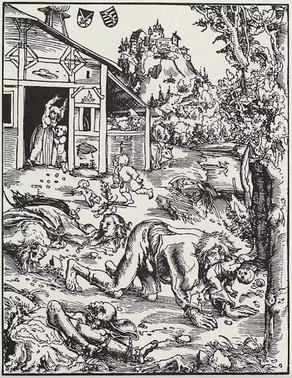
Wolfman by Frank Frazetta, 1965, original artwork cover for Creepy #4
Werewolf

Origin: Various
Combination: human + wolf
Classification: Mammal
Other Names: Werewulf, Lycanthrope, Lukánthrōpos, Garwaf,
Loup-garou
Associations: full moon, howling, horror films
Werewolves, or lycanthropes, are humans who have the ability to transform into wolves or wolf-like creatures. In certain lore, the ability to transform is based on the full moon, fits of anger, a talisman, and/or the removal of clothing. Lycanthropy is alleged to be hereditary, infectious, or induced by various sources. Some tales assert that transformation is uncontrollable and depends on a trigger, while other versions maintain that the werewolf can transform at will.
Many stories portray werewolves as bloodthirsty beasts that kill humans and other animals, though some interpretations show them as sympathetic characters who cannot control themselves, especially when in their wolf form. Many modern tales claim that while werewolves are incredibly strong and resistant to harm, they are vulnerable to silver, specifically in the form of a bullet.
Significant
Literary
Mentions
Classical
• Ancient Greek & Roman myths, specifically those of Lycaon, Niciros, and the Neuri tribe
Medieval
• Bisclavret – Marie de France
• Melion – anonymous Breton lai
Modern
• The Werewolf of Paris – Guy Endore
• Harry Potter series – J.K. Rowling
• Twilight series – Stephenie Meyer
Artistic
Representations
Throughout
History
Modern
Takes from
Cinema, TV,
& Music
Videos









